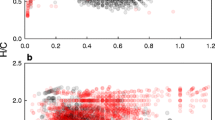Abstract
High-resolution tandem mass spectrometry by collision-induced dissociation with a linear ion trap-Orbitrap has been performed on marine dissolved organic matter (DOM). Product ion spectra of selected precursor ions (m/z 359–375) have been acquired to obtain structural information, after method development. To evaluate the performance of the method, the Suwannee River fulvic acid (SRFA) reference standard was also analyzed. By reconstructing the individual product ion spectrum of marine DOM, several fragments were assigned to the different precursor ions indicating the presence of carboxyl, hydroxyl, lactones, quinones, esters, and structures more similar to lignin-degraded molecules. On the basis of these findings, coastal marine DOM molecules, although structurally homogeneous, might be more rich in diversity of functional groups than previously described.

Reconstructed product ion spectrum to assemble the DOM structure




Similar content being viewed by others
References
Hertkorn N, Frommberger M, Witt M, Koch BP, Schmitt-Kopplin P, Perdue EM (2008) Natural organic matter and the event horizon of mass spectrometry. Anal Chem 80(23):8908–8919
Hertkorn N, Benner R, Frommberger M, Schmitt-Kopplin P, Witt M, Kaiser K, Kettrup A, Hedges JI (2006) Characterization of a major refractory component of marine dissolved organic matter. Geochim Cosmochim Acta 70(12):2990–3010
Tanaka T, Nagao S, Ogawa H (2001) Attenuated total reflection Fourier transform infrared (ATR-FTIR) spectroscopy of functional groups of humic acid dissolving in aqueous solution. Anal Sci 17:i1081–i1084
Reemtsma T, These A, Linscheid M, Leenheer J, Spitzy A (2008) Molecular and structural characterization of dissolved organic matter from the deep ocean by FTICR-MS, including hydrophilic nitrogenous organic molecules. Environ Sci Technol 42(5):1430–1437
Stenson AC, Landing WM, Marshall AG, Cooper WT (2002) Ionization and fragmentation of humic substances in electrospray ionization Fourier transform-ion cyclotron resonance mass spectrometry. Anal Chem 74(17):4397–4409
Stenson AC, Marshall AG, Cooper WT (2003) Exact masses and chemical formulas of individual Suwannee River fulvic acids from ultrahigh resolution electrospray ionization Fourier transform ion cyclotron resonance mass spectra. Anal Chem 75(6):1275–1284
Jobelius C, Frimmel FH, Zwiener C (2014) Mass spectrometric screening and identification of acidic metabolites in fulvic acid fractions of contaminated groundwater. Anal Bioanal Chem 406(14):3415–3429
Plancque G, Amekraz B, Moulin V, Toulhoat P, Moulin C (2001) Molecular structure of fulvic acids by electrospray with quadrupole time-of-flight mass spectrometry. Rapid Commun Mass Spectrom 15(10):827–835
Witt M, Fuchser J, Koch BP (2009) Fragmentation studies of fulvic acids using collision induced dissociation Fourier transform ion cyclotron resonance mass spectrometry. Anal Chem 81(7):2688–2694
Liu Z, Sleighter RL, Zhong J, Hatcher PG (2011) The chemical changes of DOM from black waters to coastal marine waters by HPLC combined with ultrahigh resolution mass spectrometry. Estuar Coast Shelf Sci 92(2):205–216
Leenheer JA, Rostad CE, Gates PM, Furlong ET, Ferrer I (2001) Molecular resolution and fragmentation of fulvic acid by electrospray ionization/multistage tandem mass spectrometry. Anal Chem 73(7):1461–1471
McIntyre C, McRae C, Jardine D, Batts BD (2002) Identification of compound classes in soil and peat fulvic acids as observed by electrospray ionization tandem mass spectrometry. Rapid Commun Mass Spectrom 16(16):1604–1609
Lin P, Yu JZ, Engling G, Kalberer M (2012) Organosulfates in humic-like substance fraction isolated from aerosols at seven locations in East Asia: a study by ultra-high-resolution mass spectrometry. Environ Sci Technol 46(24):13118–13127
Cortés-Francisco N, Caixach J (2013) Molecular characterization of dissolved organic matter through a desalination process by high resolution mass spectrometry. Environ Sci Technol 47(17):9619–9627
Blake S, Walker SH, Muddiman D, Hinks D, Beck K (2011) Spectral accuracy and sulfur counting capabilities of the LTQ-FT-ICR and the LTQ-Orbitrap XL for small molecule analysis. J Am Soc Mass Spectrom 22(12):2269–2275
Wolf S, Schmidt S, Muller-Hannemann M, Neumann S (2010) In silico fragmentation for computer assisted identification of metabolite mass spectra. BMC Bioinf 11(1):148
Kostyukevich Y, Kononikhin A, Popov I, Kharybin O, Perminova I, Konstantinov A, Nikolaev E (2013) Enumeration of labile hydrogens in natural organic matter by use of hydrogen/deuterium exchange Fourier transform ion cyclotron resonance mass spectrometry. Anal Chem 85(22):11007–11013
Koch BP, Witt M, Engbrodt R, Dittmar T, Kattner G (2005) Molecular formulae of marine and terrigenous dissolved organic matter detected by electrospray ionization Fourier transform ion cyclotron resonance mass spectrometry. Geochim Cosmochim Acta 69(13):3299–3308
Sleighter RL, Chen H, Wozniak AS, Willoughby AS, Caricasole P, Hatcher PG (2012) Establishing a measure of reproducibility of ultrahigh-resolution mass spectra for complex mixtures of natural organic matter. Anal Chem 84(21):9184–9191
Hertkorn N, Harir M, Koch BP, Michalke B, Schmitt-Kopplin P (2013) High-field NMR spectroscopy and FTICR mass spectrometry: powerful discovery tools for the molecular level characterization of marine dissolved organic matter. Biogeosciences 10(3):1583–1624
Reemtsma T, These A, Venkatachari P, Xia X, Hopke PK, Springer A, Linscheid M (2006) Identification of fulvic acids and sulfated and nitrated analogues in atmospheric aerosol by electrospray ionization Fourier transform ion cyclotron resonance mass spectrometry. Anal Chem 78(24):8299–8304
Acknowledgments
The authors thank Dr. J.A. Allué from Araclon Biotech for MS technical support and P. Eng. H. Constenla for developing the Excel macros for data treatment.
Author information
Authors and Affiliations
Corresponding author
Electronic Supplementary Material
A spread sheet data base in pdf format include all the assigned formulas for the precursor ions and fragments ions of marine DOM.
ESM 1
(PDF 131 kb)
Rights and permissions
About this article
Cite this article
Cortés-Francisco, N., Caixach, J. Fragmentation studies for the structural characterization of marine dissolved organic matter. Anal Bioanal Chem 407, 2455–2462 (2015). https://doi.org/10.1007/s00216-015-8499-3
Received:
Revised:
Accepted:
Published:
Issue Date:
DOI: https://doi.org/10.1007/s00216-015-8499-3




